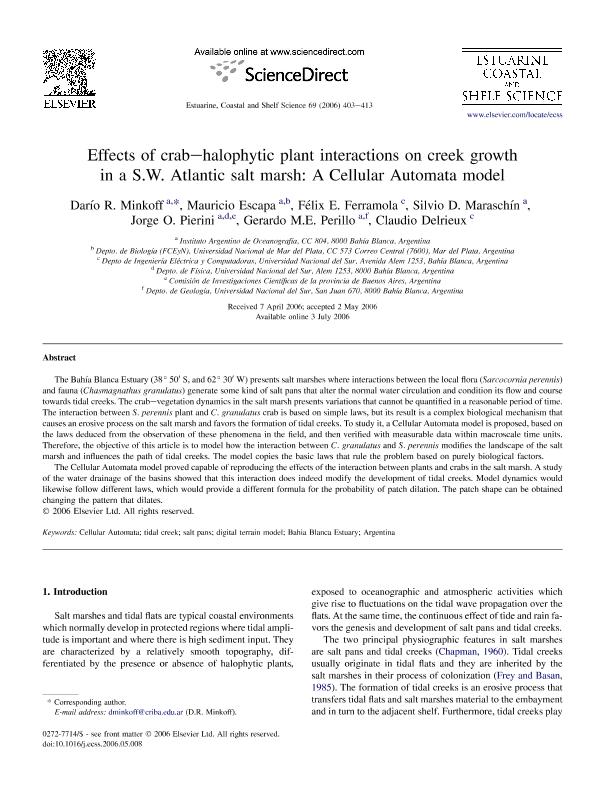Mostrar el registro sencillo del ítem
dc.contributor.author
Minkoff, Dario Roberto

dc.contributor.author
Escapa, Carlos Mauricio

dc.contributor.author
Ferramola, Félix E.
dc.contributor.author
Maraschin, Silvio Daniel

dc.contributor.author
Pierini, Jorge Omar

dc.contributor.author
Perillo, Gerardo Miguel E.

dc.contributor.author
Delrieux, Claudio Augusto

dc.date.available
2019-06-05T19:32:28Z
dc.date.issued
2006-09-03
dc.identifier.citation
Minkoff, Dario Roberto; Escapa, Carlos Mauricio; Ferramola, Félix E.; Maraschin, Silvio Daniel; Pierini, Jorge Omar; et al.; Effects of crab-halophytic plant interactions on creek growth in a S.W. Atlantic salt marsh: A Cellular Automata model; Academic Press Ltd - Elsevier Science Ltd; Estuarine, Coastal and Shelf Science; 69; 3-4; 3-9-2006; 403-413
dc.identifier.issn
0272-7714
dc.identifier.uri
http://hdl.handle.net/11336/77661
dc.description.abstract
The Bahía Blanca Estuary (38° 50′ S, and 62° 30′ W) presents salt marshes where interactions between the local flora (Sarcocornia perennis) and fauna (Chasmagnathus granulatus) generate some kind of salt pans that alter the normal water circulation and condition its flow and course towards tidal creeks. The crab-vegetation dynamics in the salt marsh presents variations that cannot be quantified in a reasonable period of time. The interaction between S. perennis plant and C. granulatus crab is based on simple laws, but its result is a complex biological mechanism that causes an erosive process on the salt marsh and favors the formation of tidal creeks. To study it, a Cellular Automata model is proposed, based on the laws deduced from the observation of these phenomena in the field, and then verified with measurable data within macroscale time units. Therefore, the objective of this article is to model how the interaction between C. granulatus and S. perennis modifies the landscape of the salt marsh and influences the path of tidal creeks. The model copies the basic laws that rule the problem based on purely biological factors. The Cellular Automata model proved capable of reproducing the effects of the interaction between plants and crabs in the salt marsh. A study of the water drainage of the basins showed that this interaction does indeed modify the development of tidal creeks. Model dynamics would likewise follow different laws, which would provide a different formula for the probability of patch dilation. The patch shape can be obtained changing the pattern that dilates.
dc.format
application/pdf
dc.language.iso
eng
dc.publisher
Academic Press Ltd - Elsevier Science Ltd

dc.rights
info:eu-repo/semantics/openAccess
dc.rights.uri
https://creativecommons.org/licenses/by-nc-sa/2.5/ar/
dc.subject
Argentina
dc.subject
Bahia Blanca Estuary
dc.subject
Cellular Automata
dc.subject
Digital Terrain Model
dc.subject
Salt Pans
dc.subject
Tidal Creek
dc.subject.classification
Meteorología y Ciencias Atmosféricas

dc.subject.classification
Ciencias de la Tierra y relacionadas con el Medio Ambiente

dc.subject.classification
CIENCIAS NATURALES Y EXACTAS

dc.title
Effects of crab-halophytic plant interactions on creek growth in a S.W. Atlantic salt marsh: A Cellular Automata model
dc.type
info:eu-repo/semantics/article
dc.type
info:ar-repo/semantics/artículo
dc.type
info:eu-repo/semantics/publishedVersion
dc.date.updated
2019-06-04T14:50:20Z
dc.journal.volume
69
dc.journal.number
3-4
dc.journal.pagination
403-413
dc.journal.pais
Estados Unidos

dc.description.fil
Fil: Minkoff, Dario Roberto. Consejo Nacional de Investigaciones Científicas y Técnicas. Centro Científico Tecnológico Conicet - Bahía Blanca. Instituto Argentino de Oceanografía. Universidad Nacional del Sur. Instituto Argentino de Oceanografía; Argentina
dc.description.fil
Fil: Escapa, Carlos Mauricio. Consejo Nacional de Investigaciones Científicas y Técnicas. Centro Científico Tecnológico Conicet - Bahía Blanca. Instituto Argentino de Oceanografía. Universidad Nacional del Sur. Instituto Argentino de Oceanografía; Argentina. Universidad Nacional de Mar del Plata. Facultad de Ciencias Exactas y Naturales. Departamento de Biología; Argentina
dc.description.fil
Fil: Ferramola, Félix E.. Universidad Nacional del Sur. Departamento de Ingeniería Eléctrica y de Computadoras; Argentina
dc.description.fil
Fil: Maraschin, Silvio Daniel. Consejo Nacional de Investigaciones Científicas y Técnicas. Centro Científico Tecnológico Conicet - Bahía Blanca. Instituto Argentino de Oceanografía. Universidad Nacional del Sur. Instituto Argentino de Oceanografía; Argentina. Provincia de Buenos Aires. Gobernación. Comisión de Investigaciones Científicas; Argentina
dc.description.fil
Fil: Pierini, Jorge Omar. Consejo Nacional de Investigaciones Científicas y Técnicas. Centro Científico Tecnológico Conicet - Bahía Blanca. Instituto Argentino de Oceanografía. Universidad Nacional del Sur. Instituto Argentino de Oceanografía; Argentina. Universidad Nacional de Mar del Plata; Argentina
dc.description.fil
Fil: Perillo, Gerardo Miguel E.. Consejo Nacional de Investigaciones Científicas y Técnicas. Centro Científico Tecnológico Conicet - Bahía Blanca. Instituto Argentino de Oceanografía. Universidad Nacional del Sur. Instituto Argentino de Oceanografía; Argentina. Universidad Nacional del Sur. Departamento de Geología; Argentina
dc.description.fil
Fil: Delrieux, Claudio Augusto. Universidad Nacional del Sur. Departamento de Ingeniería Eléctrica y de Computadoras; Argentina
dc.journal.title
Estuarine, Coastal and Shelf Science

dc.relation.alternativeid
info:eu-repo/semantics/altIdentifier/url/https://www.sciencedirect.com/science/article/pii/S0272771406001764
dc.relation.alternativeid
info:eu-repo/semantics/altIdentifier/doi/http://dx.doi.org/10.1016/j.ecss.2006.05.008
Archivos asociados
